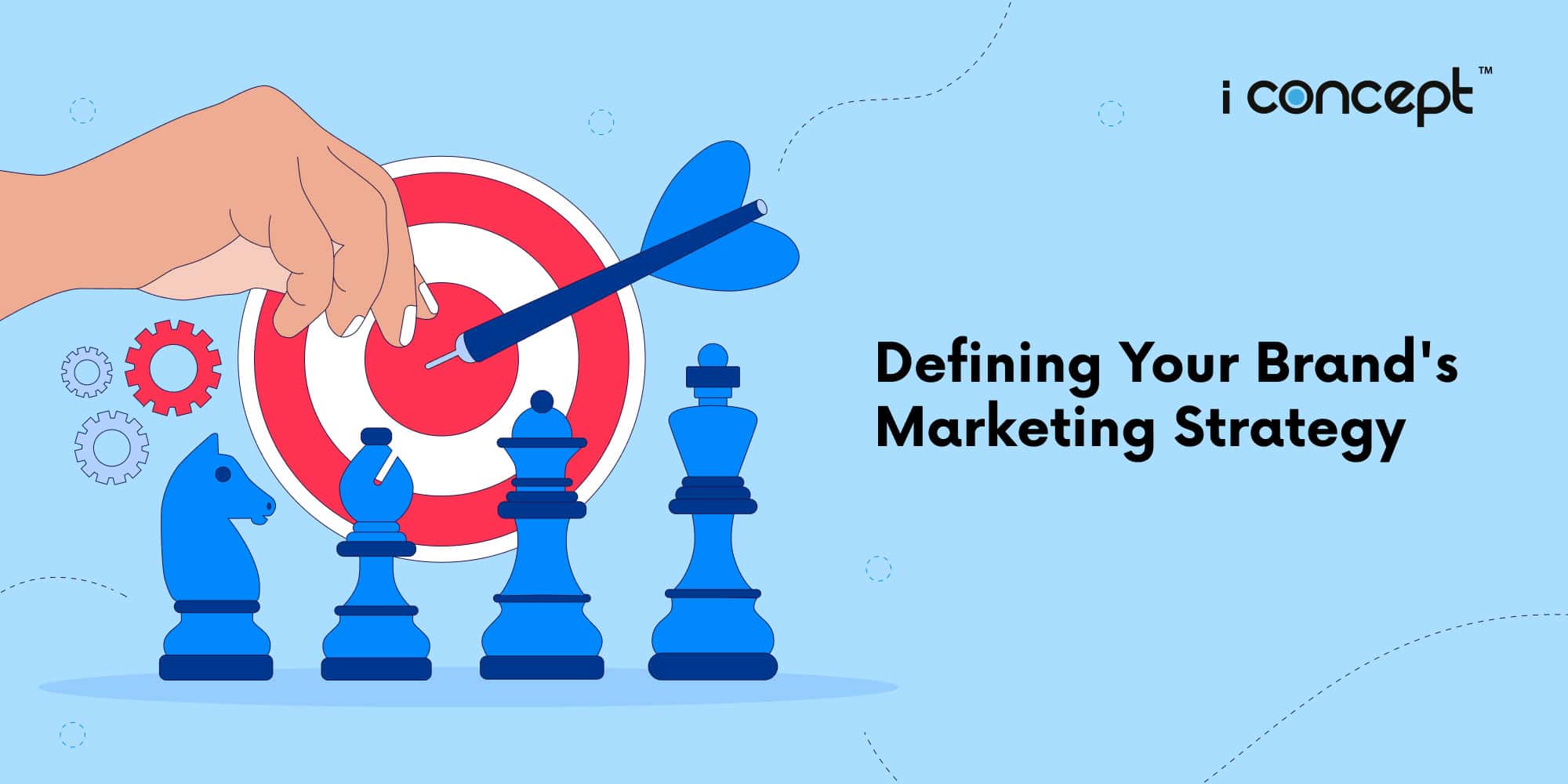Think about the iconic red Coca-Cola calligraphy or the globally famous golden arches of McDonald’s. Both are instantly recognisable brand names. But what came to your mind when you thought about them? Was it the colour, the logo design, or their brand positioning?
Well, maybe it’s a mix of all of the above.
A colour or a design alone does not define a brand. It’s the complete brand strategy that includes the core identity, messaging, communication, and overall customer engagement that attracts customers to their favourite brand.
Thoroughly developing and implementing creative branding ideas will help you build an online presence that will grab the attention of your audience.
Here, we’ll guide you through the steps on how to develop a proper, comprehensive branding strategy for your business. And also, we’ll see how a branding agency can help you with it all.
What is branding?
Your company’s brand communicates what your company stands for, what you aim to do, and what you can offer to your audience.
Your logo, all your graphics, and the colours associated with your company comprise the visual aspect of your branding.
The words your company puts out and the causes you stand for make up your company’s voice. Even the products and services you sell tell a lot about your company. All these combine to make up your company’s branding as a whole.
And branding is ever more important in the age of e-commerce and digital marketing, where things are seen mostly online. Strong branding will attract the right eyeballs.
Why does your business need to develop a brand strategy?
Creating a clear, compelling, and memorable image in the minds of your company’s audience is not something quickly done. It requires a clear-cut plan and thoughtful execution.
In short, developing your brand strategy is about telling your brand’s story. Brand storytelling shares why you started your business, the journey to get where you are now, and the values and principles your company holds dear. That way, your customers can connect with you at a deeper level.
More importantly, your brand impacts your businesses’ bottom line. That’s because customers are more likely to support brands that they remember.
Steps to develop a brand strategy
- Audit your current branding and marketing strategy
Before planning your strategy, you have to know where you stand now.
From the moment your company was made, you’ve already been building your brand. The first step to finding out what your company branding is to ask yourself: “What is the point of my business?”
Your company exists for a reason. It could be as simple as: “There was nobody providing products like mine in my area.”
The fact that you sell those products to people in your area already equates your brand with the message that you want to contribute positively to your community.
Take note of how you’ve been communicating with customers on social media and through your other support channels. Find out how your logo would make others feel. Find out what your customers feel and think when they do business with your company.
These are all things that your customers already identify you with, and these are the building blocks upon which you can build upon or pivot your marketing strategy so that you can continue growing.
- Develop your buyer persona
A buyer persona is a profile of an ideal target customer.
Here is a brief list of the essential data your buyer personas should have:
- How old is your customer?
- Is your customer a man or a woman?
- Where does your customer live?
- What’s your customer’s household income?
- What does a typical day for your customer look like?
- Are there any causes your customer supports?
- Why is your customer buying your product?
- How does your customer use your product?
- How often does your customer buy your product?
- Why wouldn’t your customer buy your product?
- How does your customer like to communicate? (Social media, emails, texts, etc)
Developing your buyer persona involves studying your customer data, as well as the data of your competitors and data from market research.
- Determine your business’ vision and mission
Your company’s vision and mission state what your company is now, and what it aims to be. They guide your company to make sure your actions and goals are all aligned and going in the right direction.
A vision statement describes what your company hopes to be. This statement provides the direction for your company. It provides the long-term goals your company wants to achieve through what it’s doing now.
Your mission statement describes what your company currently is. It explains what your company does, how it does its business, whom it helps, and why they do it. This statement is short-term, as it only outlines the steps your company is taking to achieve your long-term goals.
The vision and mission statement work hand-in-hand to condense your brand in a few words. They should be clear and comprehensive enough that your customers can read them and know what your brand is.
- Be clear about your ‘why’
Before promoting your products to your customers, you have to think about why you set up your business in the first place.
The ‘why’ of your company is the purpose of every action you take in your company.
61% of consumers want brands to take a stand for causes they believe in.
When making your company’s purpose, find out what causes and beliefs you will promise to uphold every step of the way – not just for your customers, but for the company itself. Every time you decide on something for your company, it should always go back to your ‘why’.
- Identify and analyse your competitors
Your competitors are the other companies who can satisfy the needs of your target customers. The most obvious competitors are grouped into three categories: primary, secondary and tertiary competitors.
After identifying these competitors, it’s essential to analyse them. In developing a brand synergy, what’s important to take note of in competitive analysis is how they present themselves to customers, and how customers perceive them.
Take note of your biggest competitors and see what they’re doing right, and what they still aren’t doing. Some industries have best practices already in place, so following those best practices can be an excellent foundation for a long-lasting, effective brand strategy.
- Develop your branding identity
When customers think of your brand, a clear, distinct, and unique message should pop up in their head instantly. Your brand identity is that message. It’s a message formed by your brand’s name, logo, tone, tagline, and everything else you’ve put out for your audience.
This identity sets the tone for your brand, and a consistent effort to reinforce this identity just makes your brand more influential in the minds of your audience.
You have to make your brand identity strong enough to your audience so that when they see your brand’s logo — or even just something related to your brand — they instantly think of your brand.
- Set up your website
Business owners have to make their website attractive and usable for their customers now more than ever. That’s because it increases the direct sales you get from consumers researching your product.
Having a comprehensive website that informs your audiences of everything you want them to know about your brand is an advertisement in itself.
Keep in mind to follow the best website practices to make a great branded website. This includes using great photos, keeping a clean and straightforward site, and making your website accessible on mobile.
- Develop your content marketing strategy
Content marketing is creating content for your brand that your audience would consider helpful and valuable.
Each piece of content you produce should ask your audience to take action — usually, that action is to buy your product or service.
The reason for putting out content works is because 88% of consumers research a product or service online before they make a purchase.
Other reasons to do content marketing include its low cost, the increased visits to your company’s website, and better search engine results.
Of course, the type of content your company produces should depend on your company’s content marketing strategy.
For example, case studies are useful for content marketing agencies because they creatively showcase their work. They get to tell their audience a story, but also advertise their services while they’re at it.
Develop your content strategy so that you can always regularly update the content you put out. This ties in with the consistency your brand needs to establish a strong brand identity.
An effective brand strategy can help you build a solid presence
Having a concrete, well-researched, and adequately managed brand strategy can be the key to your digital marketing efforts. The strategy serves as a blueprint of your company’s success, and investing in your brand strategy will pay off once your company gets closer and closer to achieving its vision.
Need assistance in developing a comprehensive brand strategy? Contact the branding agency that’s in the know. I Concept Singapore is here to help walk you through, from assisting with market and competitor research, to creating a set of brand visuals and identity that talks, and helping you pick the right words to communicate what your brand is all about. We can also develop digital marketing campaigns right for you, as well as creating a website that attracts the right visitors for your business.
Contact us today, and allow our team of brand guardians to journey with you to create the most suitable website for your brand. You may also tap on up to 50% funding support from Enterprise Singapore to raise your brand equity via the Economic Development Grant for Strategic Branding and Marketing. We’re a pre-approved vendor for just that.
Brand your business right with a solid branding strategy, and witness its dynamic growth.










